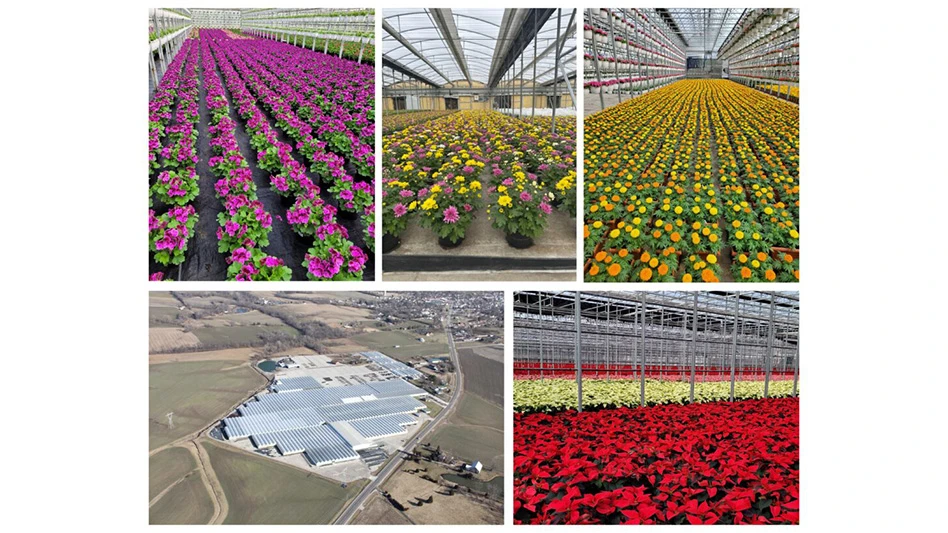

Cut flowers were the crop that led to the United States’ greenhouse industry. While cuts were traditionally grown in mineral (“field”) soils in the ground or in ground beds containing field soil under protection, most commercial cut flower production in greenhouses occurs in hydroponic or soilless production systems..
Let’s review some of the hydroponic and soilless systems available for producing cut flowers.
Slab culture
One popular system for growing cut flowers in greenhouses should be familiar to grower producing tomatoes hydroponically. While slabs of rockwool are a popular choice for many vining and fruiting vegetable crops, they are also well-suited for hydroponic cut flower production. Most slabs are around 1-yard (or 1-meter) lengths, different widths and depths available to accommodate the needs of different crops and their root systems. A primary reason why rockwool is so well-suited for long-term cut flower crops (roses, for example) is the long lifespan of the substrate. Since rockwool is an inert, inorganic material, it will maintain its physical integrity for a long time which, in turn, maintains the desirable physical properties for root systems throughout the long cropping cycle characteristic of many cut flower species.
Individual containers filled with loose-fill substrate can also be used to produce cut flower crops. Suspended at heights comfortable for working canopies and harvesting, containers are filled with soilless substrate plants are transplanted into and grown on continuously throughout production. Coconut coir, as seen in Fig. 1, is a popular choice for use as a loose-fill substrate in containers. Unlike rockwool, coir is an organic substrate; but, like rockwool, coir can maintain physical properties longer than other organic components such as sphagnum peat moss. Coconut coir has a high lignin content which, in turn, resists breakdown by microbes and subsequent decomposition. Other substrate components can be amenable to use in container culture, if they are well-matched to the crop time. For instance, sand or perlite can be used in containers as a growing substrate .

Bulb crate & soilless in-ground production
“One person’s trash is another person’s treasure.” That well-worn statement is very fitting for bulb crates. Bulb crates can form the basis for a simple soilless cut flower production system. By filling bulb crates with soilless growing substrate such a traditional peat-perlite mix, planting them, Furthermore, the planted crates can be arranged in the greenhouse in “beds” and supports placed above them.
This simple system also allows for flexibility between different crops. Depending on the length of cropping cycles, the substrate may be able to be pasteurized and reused if the organic material has not broken down too much, thus maintaining its physical properties.
The focus of this article is on hydroponic or soilless methods of cut flower production, so it may seem a bit out-of-place to discuss in-ground production of cut flowers as hydroponic. However, when the “soil” is an inert material such as sand (Fig. 2), the system is functionally a hydroponic one - where the substrate has little-to-no-influence on the chemical properties of the root zone.
Regardless of which of the systems mentioned above are used, they are all similar with respect to irrigation. The vast majority of systems use some type of drip irrigation system, where the nutrient solution is delivered to the surface of the growing substrate. Overhead irrigation is roundly avoided with greenhouse-grown cut flowers for a variety of reasons, from maintaining flower quality to avoiding diseases. For several of the cut flower production systems discussed in this article, micro tubing and drip stakes are used to irrigate plants, while for other systems turbulent twin-wall tubing or “drip tape” can be run down plantings.
Like hydroponic nutrient solutions for food crops, cut flowers commonly have at least two different nutrient stock tanks:the “A” and “B” tanks. This allows high concentrations of nutrients including calcium to be provided to plants, without risking precipitation of calcium with sulfate as insoluble calcium sulfate.
Cut flower production has evolved with the greenhouse technologies they helped spur development of in the U.S. Across the spectrum of production systems available, many cut flowers grown in greenhouses employ hydroponic systems of one type or another, as this article has demonstrated. Perhaps one of these systems, or a variation on it, will prove useful in your greenhouse.

Explore the May 2021 Issue
Check out more from this issue and find your next story to read.
Latest from Greenhouse Management
- Terra Nova Nurseries introduces rust-free and disease-resistant heucherella
- John T. Nickel, founder of Greenleaf Nursery Co., passes away at 89
- Three tours offered at 2025 Farwest Show
- Garden Media Group announces sixth annual Women in Horticulture Week
- Star Roses and Plants announces National Knock Out Rose Day
- The Growth Industry Episode 4: How federal budget cuts are affecting horticulture nonprofits
- The thrips battle plan
- Pennsylvania Horticultural Society shares top gardening trends from 2025 Philadelphia Flower Show





